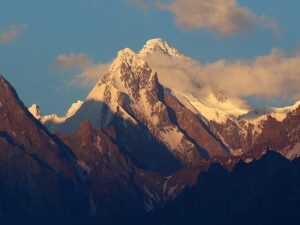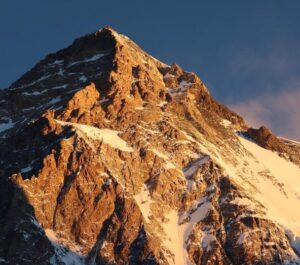Ignacio Lucero of Argentina raised concern when he set off alone from Camp 3 toward the summit of Broad Peak two nights ago. One day before, a group of climbers had to retreat at 7,500m because of buried ropes and an avalanche-prone slab on top of unstable snow.
Saulius Damulevicius, still at Camp 3 after his attempt, assessed Lucero’s climb as “very risky, unless conditions dramatically change.”
Today, the sight of Lucero walking safely into Base Camp has relieved the tension. After some rest and lunch, Lucero himself answered ExplorersWeb’s questions. (The new antenna at Concordia is now functioning.) His story throws new light on the events. He was eventually in danger, but not above Camp 3.
First of all, he says that he spoke with climbers back from their recent summit push and carefully assessed the situation before trying to go higher on Broad Peak.
“I heard about the avalanche hazard, but I also saw that snow conditions changed a lot the following day,” he said. “It was really hot, which melted the snow a great deal. Then temperatures dropped radically, and the following night was very cold.

A climber at Broad Peak’s Camp 3. Photo: Fotis Theorachis
Not reckless
“I am a professional mountaineer and a ski instructor, so I am more than familiar with the changing snowpack. My perception of the situation was somehow different from the other climbers, so I decided to go up and check conditions by myself, step by step,” the climber from Mendoza (Aconcagua area) said. “I also intended to climb at night, when conditions are more stable.”
He added that some climbers stop their attempts based only on the opinions of other climbers. “I believe that I have to be self-sufficient and trust my own perceptions based on knowledge and experience,” he said.
Lucero insists that his attempt was neither reckless nor emotional. “On the contrary, it was based on my experienced assessment of the elements, and I constantly checked the conditions.”

Climbers on the previous summit push, July 26-27. Photo: Fotis Theorachis
In fact, it was not the avalanche risk that eventually pushed him back, 200 vertical metres above Camp 3.
“The weather worsened, it started to snow, and forecasts expected the snow to continue falling,” he explained. “With lower visibility and fresh snow, my progress would be slower, and I had to think not only of the ascent but mainly of the descent. Still, I think I could have gotten further had I not been alone.”
Lucero is glad that he decided to retreat, because the descent was “very delicate, in fact dangerous,” from Camp 2 downward.
Rockfall and poor ropes
“The hazard was mainly rocks falling constantly on the route,” he said. “But I also had a few hair-raising moments because of the poor state of fixed ropes.”
Other Broad Peak climbers, including Fotis Theorachis, also mentioned their close calls while descending from C2. As the snow covering the rocks melted, loose rocks fell on the climbers and the ropes. Sometimes rocks became loose when climbers stepped on them and fell later. There were also broken or damaged ropes.
Lucero is now safely down and will return to Skardu tomorrow with the long caravan of climbers who are now abandoning the Base Camps of Broad Peak, K2, and the Gasherbrums.
Note: Lucero had no phone (we spoke through Akhbar Syed’s) and will not be able to share photos until he reaches Skardu. The photos illustrating this story are mostly by Fotis Theorachis, who participated in the collective summit attempt on July 26.






